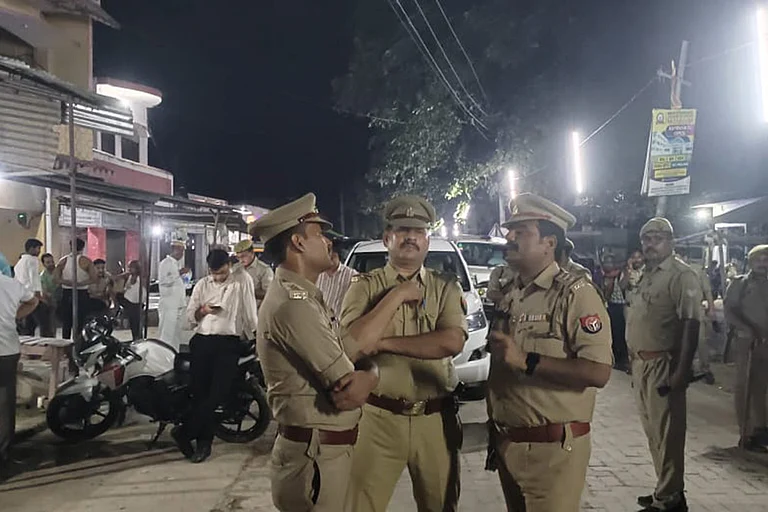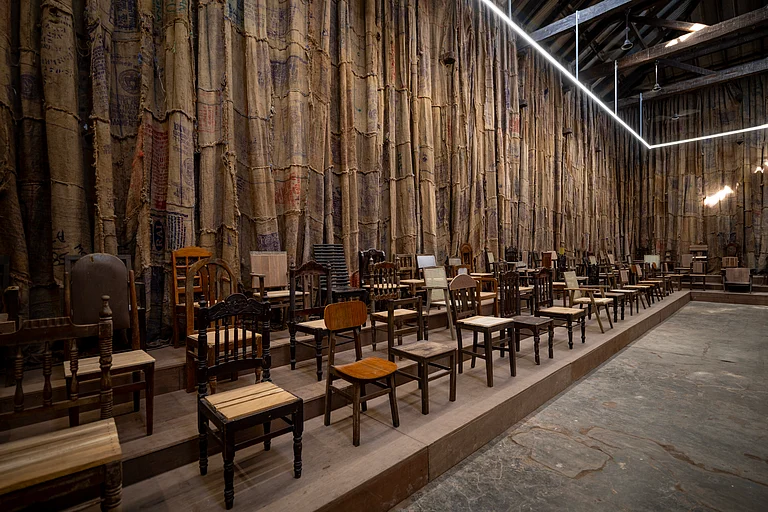Trigger Why we are doing this story
- According to FAO estimates, India’s forest cover has gone down by 2,50,000 hectares in the last 20 years.
***
From a distance, Timbaktu seems like a mirage. The hilly terrain around is scrub country, angry red soil, thorny bushes, not a sign of water anywhere. In the middle of this is a lush green forest with over 400 species of swaying trees, bushes and creepers. This is Timbaktu, on the edges of Chennakothapalli village in Anantapur, one of India’s worst drought-prone districts where farmers have to coax their parched land every year to grow a crop of groundnut, sunflower or jowar. Tough weather conditions, deforestation and bad agricultural practices over long periods of time has left the farmer and the land on desolation road.
Timbaktu too seemed caught in the vortex when Bablu Ganguly and Mary Vattamattam first saw it about a decade-and-a-half ago. When the couple, along with a friend John D’Souza, bought 32 acres of this barren land near Chennakothapalli, friends shook their heads in disbelief at the misadventure. But Bablu and Mary were believers chasing a dream, armed with Japanese scientist Masanobu Fukuoka’s cult book One Straw Revolution. “We spent all our savings in buying 7,000 saplings, planted them and waited. Sure enough, nothing happened. We had assumed Fukuoka’s philosophy of ‘do-nothing farming’ literally meant do nothing. But what he actually meant was do nothing to the soil in terms of fertilisers and pesticides,” laughs Bablu.
They soon realised that the soil would yield only if they protected the trees and water bodies around the land. With their plan on revitalising and restoring the soil, the couple began educating nearby villagers. They drew up lessons on fire and grazing control, seed planting, cutting only branches for firewood, water harvesting and soil conservation. Mud bunds and tiny check-dams were built. The local bodha grass seeds were propagated and the hay from this used as fodder. “We began working on agriculture and agro-forestry from a sustainable point of view. Farmers around us understood agriculture and animal husbandry but we needed to regenerate the forests by getting everyone involved,” explains Bablu.
Their efforts began yielding fruit in some three years and the soil started to spring to life again. Bablu and Mary began collecting locally available seeds and built a library. Some pioneer tree species—which are the first that can be grown in harsh conditions and enable further greening by nitrogen-fixing the soil—were nursed back to vitality. At Timbaktu, a multi-cropping pattern is followed, giving the fragile soil time to replenish itself. Groundnut, paddy, maize, millets, pulses are grown alongside vegetables like brinjals, tomatoes, ribbed gourd, chillies and fruit like chikoo and mangoes. The farming is completely organic; all chemical-fixing fertilisers are banned. Timbaktu also harnesses a lot of solar power for its needs.
The quaint mud-cottages surrounded by whispering neem, karanj (pongamia) and anjan (hardwickia binata) trees make Timbaktu look like a place that came readymade as a nature getaway. In reality, it’s the choices the owners made in redesigning farming practices from scratch that revitalised the land. “Nature has a great capacity to regenerate itself. We just have to give her the space,” says Mary softly. She relates how their success at Timbaktu so excited the couple that they are now intent on sharing their knowledge. “We began experimenting in nearby villages,” she says. Bablu and Mary now advise farmers in 100-odd villages on the advantages of agro-forestry, natural farming and non-pesticide management.
Their work on 7,000 acres of wasteland at nearby Kalpavalli, a cluster of nine villages, has created another green haven. They now focus on joint village ownership of the forest and its produce. The farmers intuitively understand how the soil, forests, fodder and animals are all interlinked—about 1,100 Holkar cows, whose urine and dung is considered the most fertile, were brought in to graze in the wastelands. About 250 water bodies and springs have come back to life here. “I would say, post-Independence, the amount of destruction of land in India has been unprecedented,” says Bablu. “High-water, high-chemical farming can destroy even fertile soil. Look at Punjab, where the groundwater is totally poisoned. When the same techniques are used in dry-land areas, it’s suicidal.”
Bablu and Mary say that involving the community is a very important part of practising sustainable agriculture. They start small and move on to bigger areas. There are regular reviews as well. At the village of Brahmanapally, when Mary talks to farmers about the ill-effects of chemical fertilisers and global warming, they understand perfectly. It’s not an alien concept to them. Based on experience, the duo say a village takes about three years to become fully convinced on going organic. How tough is it to wean farmers off fertiliser use, which gives quick results? Don’t some of them resist Timbaktu’s methods? Mary replies, “We are also open to change. Villagers will only take forward those techniques that are relevant and viable. If not, they will dump them.”

Let’s talk green Overview shots of Timbaktu. The landscape was transformed in just 15 years.
Timbaktu believes in getting the community, especially younger people, involved in sustainable agriculture practices and afforestation. A school is run on its premises for children of farmers in nearby villages. Set amid the natural setting of trees and birds, this school not only provides a proper education for 100-odd children but also healthy meals. Mary and Bablu, both 55, seem to have built this alternative model with great attention to detail. “Do you know what tree this is?” asks Bablu, hugging a trunk. “It was planted by a student from the first batch and look how tall it’s grown.” It is easy to see why children who grow up in such an atmosphere understand the importance of protecting the environment.
“What we are doing really is preparing the community for climate change mitigation,” says Bablu. His Marxist leanings had led to work in the area of land redistribution when he was younger. Both he and Mary have lived and worked in Andhra Pradesh for over 30 years now on various social projects. But it is with Timbaktu that they found their true calling. While Bablu is Bengali and Mary a Malayali, they consider themselves to be truly Telugu as do their three grown children. The bright red, green and yellow Rastafarian colours on the doors of their quaint house seem to be the only concession to some flamboyance. The couple are also part of several climate and agri networks. Right now the Timbaktu collective is participating in a research by the Fair Climate Network. The research, spread over Rayalaseema, Telangana and north Karnataka, aims to study how organic farming can reduce carbon footprint. Gasifiers and GPS technology are being used to compare carbon emissions in conventional and organic farming.
The difference is clearly visible in the villages where Timbaktu has realised its own Fukuoka revolution. The whitish, calcified sheen on lands where groundnut is grown with regular pesticides and fertilisers is a dead giveaway. The farmers in the villages where forest/water conservation is practised see that their soil is still moist even though rains have been delayed this year. Microbial activity has returned to their fields owing to use of organic fertilisers. Crop rotation is a common conversation point now because farmers no longer want to gamble all their money on one crop that may or may not bear a good yield. “Farmers now have the freedom to choose what they want to grow and not be dictated to by industrial agriculture. Pushed into this vicious cycle of hybrid seeds, fertilisers, loans and dead soil, they were concentrating on cash crops. Organic farming, in a way, has given the farmer the independence to choose what he wants to grow,” feels Bablu.
There was a time when there were only scrawny scavengers and a few predatory birds circling Timbaktu. Now, as you walk down into the dense forest, you can spot animals like wild boar, black buck, fox, porcupine and on rare occasions even a leopard. The forest is also alive with bird calls: peacocks, tailorbirds, bulbuls, purple sunbirds, Indian robin, crested larks, they are all a common sight. The germ of an idea of restoring soil might have come out of a book but today, Timbaktu, their dream, is alive and real and it’s no mirage. In fact, it holds up a map of a possible world to all villages in the region.
***
Also New Delhi March 14, 2011
- The big cats are roaring again—all 1,706 of them. The 2011 tiger census released in March this year (only the second such study in the country) gave conservationists reason to cheer as numbers of the Royal Bengal showed a 20% rise, from 1,411 in 2008 to 1,706 in the 39 big cat reserves across India. Karnataka earned its stripes, topping the list with 300 tigers. MP was second with 257.


























